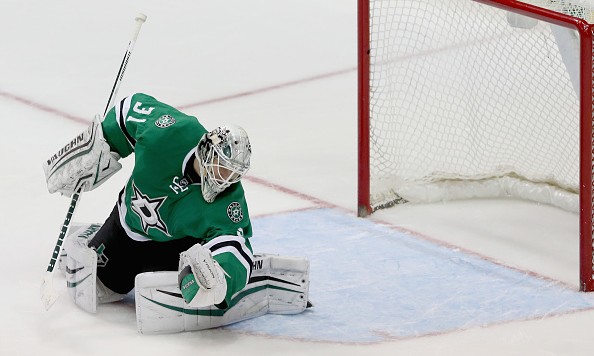The Dallas Stars have a problem. By extension, those who have put their hopes on the Stars winning the Stanley Cup as a sort of momentum-starting, change-springing event, eventually leading to teams valuing offense and playing less conservative have a problem.
The Stars are the highest-scoring team in the NHL and play a fast-paced entertaining brand of hockey. They’ll likely be the postseason rooting choice for fans who are turned off by the low-scoring, grabby, dragged-down, oober-conservative direction the NHL has taken over the past two decades.
But there’s a problem. Actually, two problems.
Antti Niemi and Kari Lehtonen.
The Stars have sat at or near the top of the Central Division for much of the season. Jamie Benn and Tyler Seguin are second and third in scoring in the league, respectively. Jason Spezza is in the midst of a resurgence. John Klingberg has enjoyed a breakout season. Johnny Oduya and Patrick Sharp have both been great additions. The Stars are third in the NHL in even-strength score-adjusted corsi at just over 53 percent.
But a hot start to the season masks a recent slide. After starting 26-7-2 in their first 35 games, the Stars are 15-14-7 in their past 36.
The possession numbers have remaining strong. Seguin and Benn are still Seguin and Benn. The depth is solid. But the goaltending has been brutal.
On the season, Niemi has a .901 save percentage in 44 games played while Lehtonen’s is at .903 in 36 appearances. In this current scoring climate, that’s atrocious. It’s bad enough to ruin the league’s most exciting offensive team.
As one would expect, the goaltending woes have coincided with the second-half slide. Niemi took on most of the starts early on, but Lehtonen has been given more responsibility of late.
Niemi’s season started respectably enough, with a .915 save percentage in October, before dipping to .901 in November. He recovered by posting an awesome .936 in December, but that’s where the fun ended. He posted an .888 in seven January starts, .870 in eight February games and has allowed 10 goals on 65 shots in three March appearances.
Over the past three months, Lehtonen has posted save percentages of .901, .898 and .885. An improvement over Niemi, but still not nearly good enough.
To put things in perspective for the playoffs, I took a look at the goaltending situations for teams that advanced to the Stanley Cup Final over the past 10 seasons. Dallas is 29th in the league in even-strength save percentage. No team that has finished that poorly has advanced to the Stanley Cup Final in that timeframe.
Of the 20 that have advanced, 12 had even-strength save percentages that ranked top 10 in the league, five ranked between 11 and 20 and just three ranked lower than 20. One of those three was the 2011-12 Devils, who were 21st, which still isn’t really comparable to this iteration of the Stars.
The worst teams in this regard were the 2005-06 Edmonton Oilers (25th) and the 2009-2010 Chicago Blackhawks (27th). The Oilers are easily the least likely Cup finalist of the past decade. The roster was solid, but not spectacular. The teams used four goalies during the regular season – none had much success. A deadline trade brought Dwayne Roloson in from Minnesota. Roloson was named the starter but had a modest .905 save percentage in the final 19 regular season games.
Then weird stuff started happening. Edmonton ran into three straight great teams that inexplicably each had goaltending meltdowns. Meanwhile, Roloson shined with an incredible .931 save percentage in the first three rounds (remember, this was the first post-lockout scoring boom year – .931 overall was insane at that point). In hindsight, the luck was incredible. The Oilers probably should have lost each series and got carried by the same thing that held the team back all season. Dallas really can’t take anything from this because it’s not likely to ever happen again.
The other situation is more interesting, and not just because Niemi is directly involved. For most of the 2009-10 season, the high-priced Cristobal Huet was Chicago’s starter. But, after posting an .895 save percentage, he was benched for Niemi.
The 26-year-old Finn did not disappoint, but didn’t exactly shine either. He put up a .912 save percentage in the regular season and .910 in the playoffs. That was good enough to win with one of the great offensive attacks we’ve seen in the past decade (Kane, Toews, Hossa, Byfuglien, Ladd, Sharp, Bolland, Brouwer and Versteeg).
This is the model Dallas should hope for. Hoping Niemi or Lehtonen has a Roloson-type run is an insane pipe dream. But hoping for some mediocre goaltending while the offense goes on a two-month hot streak? That’s a very plausible scenario.
Unfortunately for Dallas, average is far cry from the type of net-minding the Stars are getting right now. If things continue to trend the way they have the past three months, the league’s most-exciting team could face an early exit.

